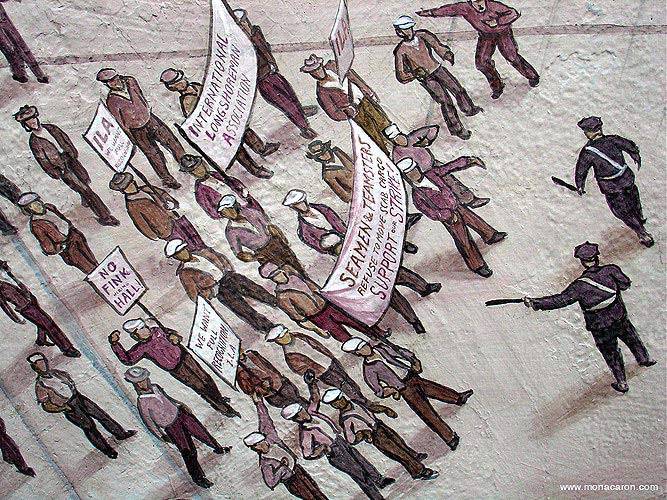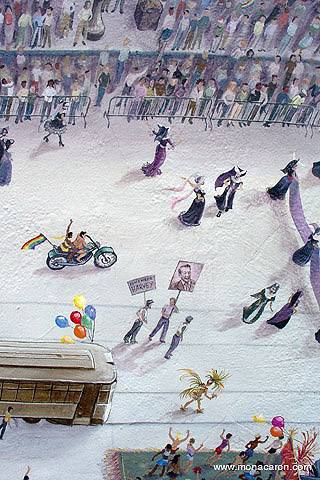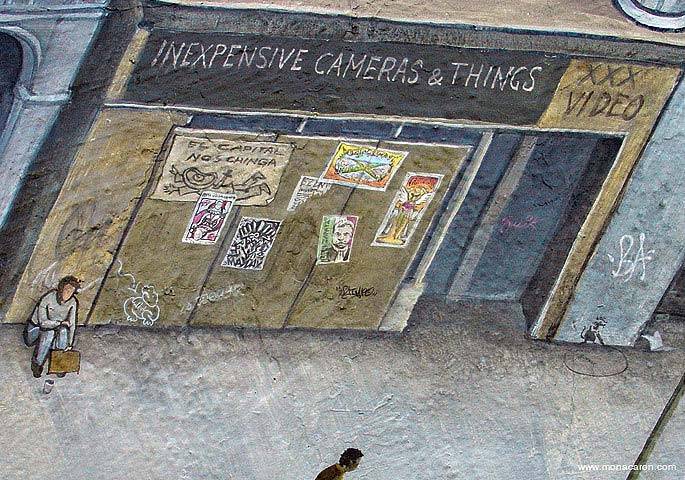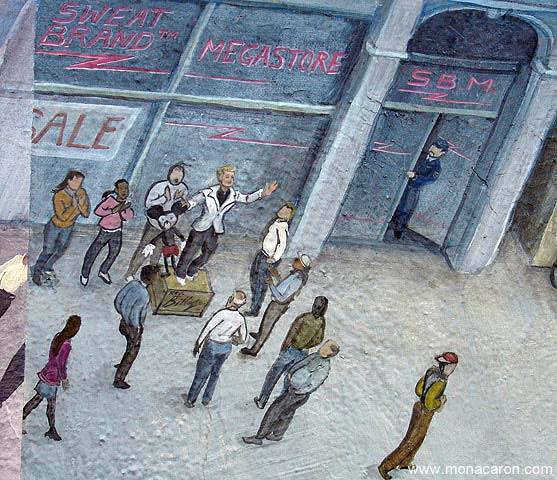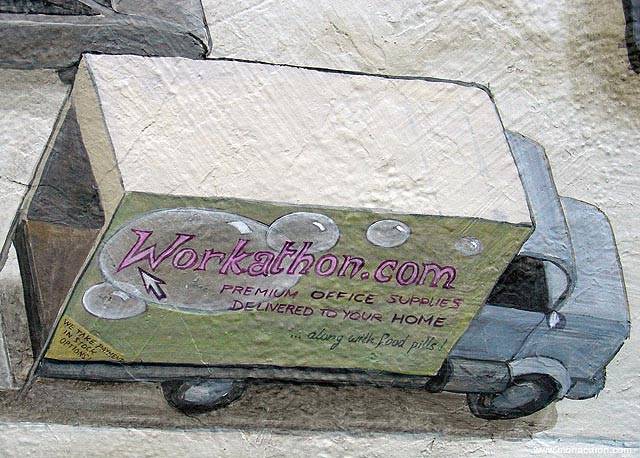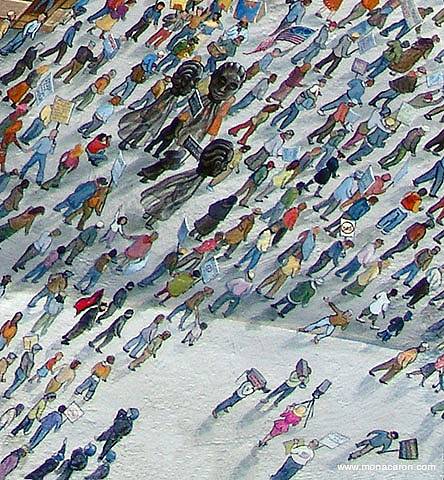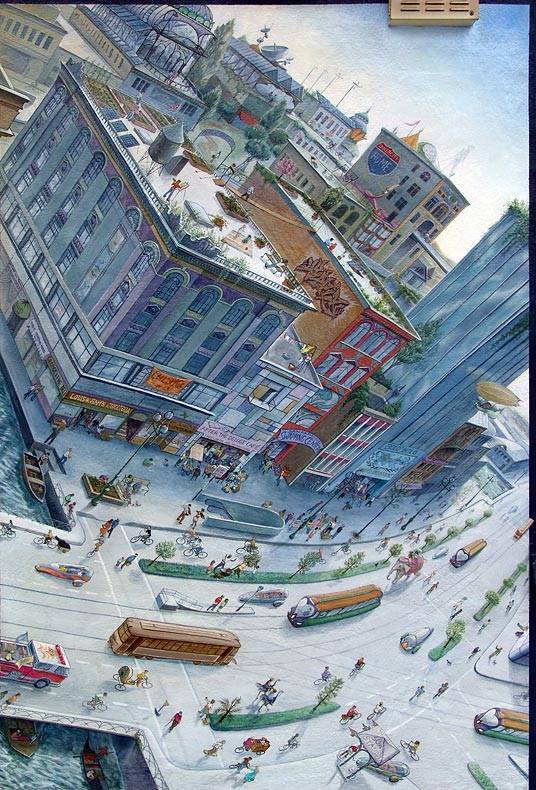Time-Travelling Wall
Historical Essay
by Chris Carlsson
Mural: Mona Caron, Photo: Michael Rauner
Mona Caron’s Market Street Railway Mural (MSRM), at 15th and Church, is on the outer fringes of Mission Muralismo geographically—and even stylistically. No other mural in the city contains so many specific histories, rendered with such detail. A true heir to Rivera’s sprawling and encompassing Pan-American Unity mural at City College, the MSRM starts in the 1920s, during the last go-go decade of speculative frenzy and stock market madness. The “roar of the four” characterized a Market Street with four streetcar tracks where private and public capital competed for passengers at 5 cents a trip.
The Big Strike of 1934 enters the picture in the adjacent panel—a compelling saga itself, but this depiction is also an oblique homage to the new social-commenting frescoes in Coit Tower that were hidden from the public until months after the strike was over.
Labor wins respectability on the picket line, on the job, and in politics—the third panel features a large 1940s Labor Day parade. Buses join cars in a traffic jam at mid-century and mid-mural while Market Street lives up to its name with thriving retail.
Gay pride takes over the street by the late 70s, the iconic Sisters of Perpetual Indulgence joining thousands to dance out of the closet, while one couple commemorates murdered political leader Harvey Milk. In the wider panel (third to last) a gritty view of the Grant Building at 7th and Market (itself home to three large murals by former Mission muralist Mike Mosher) is next to a rooftop featuring the Billboard Liberation Front in action. From the front door bicyclists are leaving, some already in the street—the Committee for Full Enjoyment is departing for Critical Mass c. 2002 (10th anniversary posters are on the storefront window).
A short distance down the sidewalk performance artist Rev. Billy is exhorting some stop-shoppers.
Two trucks deliver messages: the first, Globalization, Inc. also has an anti-WTO graffiti on it; the second is a bubble-decorated van delivering for Workathon.com, promising to include food pills with deliveries, and offering to take payment in stock options. An empty storefront facing the traffic was once home to Megabubble.com but is just a graffiti gallery now.
Leaning precariously to its left, the Grant Building is home to many participants in the big February 15, 2003 protest against the Iraq War: dozens of San Francisco’s activists, artists, and agitators show up in the building and the full street below. Puppets, drumming, and humorous signs capture the fierce jubilation with which people refused consent to the illegal and unconscionable war. Even the mainstream media’s obsequiousness is jabbed in the lower foreground.
Abruptly, in the middle of 7th Street, the long-subterranean river has appeared, fully integrated into an aquatic urban life. Today’s marginal, unheralded, but often visionary efforts are projected into an ecotopian future San Francisco in the right-most panel. On the roof of Cellspace #13, today’s Odd Fellows Hall, the artist depicts herself, painting the skyline and roof gardens filling her view. An historic streetcar has made it across all the time periods into a future with blimps, elephants, and plug-in solar carts joining bicyclists and streetcars and pedestrians in an apparently stress-free transit paradise. The Diggers reappear in a canal-side building next to the No Penny Opera, a free dining experience with roots in the flamboyant Angels of Light. A Swapping Center stands between a café dedicated to intellectual debate and a global self-governance facility called bolo’bolo (from the book of the same name by the Zurich-based writer p.m.). Rigo’s Inner City Home is portrayed, as is “Utopia” of wildstyle graffiti artist Satyr. Foliage drapes buildings while windmills slowly gather kinetic energy and a semi-permanent Burning Man looks over it all contentedly.
Caron hails from Intragna, the same village in southern Switzerland that Gottardo Piazzoni emigrated from in the late 19th century, establishing himself as a San Francisco muralist. One hundred years later Mona Caron has carved out a wholly original style of public muraling, echoing faintly Piazzoni. But in the Market Street Railway Mural she has built on Diego Rivera’s legacy of detailed historicity and time periods that bleed into one another to create a remarkable window on San Francisco’s most prominent street and the many movements and peoples that have inhabited it.
--Chris Carlsson
Audio:
<iframe src="https://archive.org/embed/ArtPoliticsMonaCaron" width="410" height="50" frameborder="0" webkitallowfullscreen="true" mozallowfullscreen="true" allowfullscreen></iframe>
Mona Caron on Art & Politics, A Shaping San Francisco Talk, Sept. 19, 2007
Caron's Noe Valley Mural, completed September 2008



